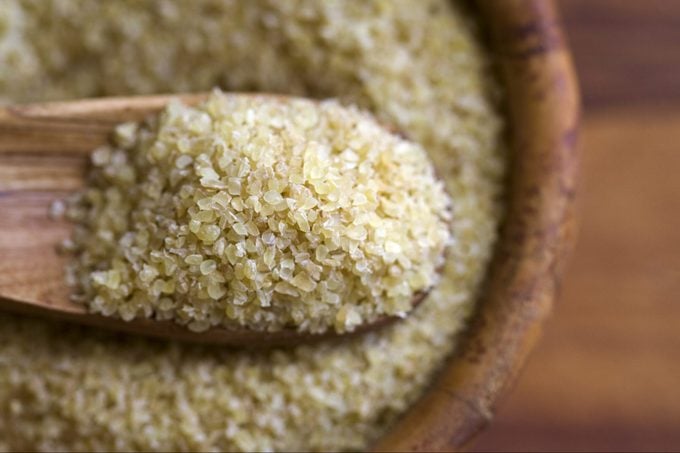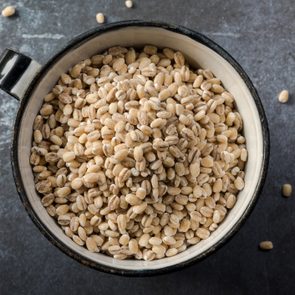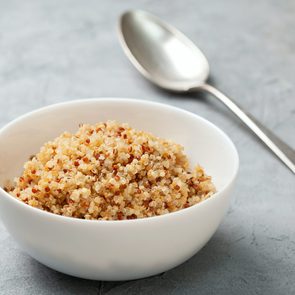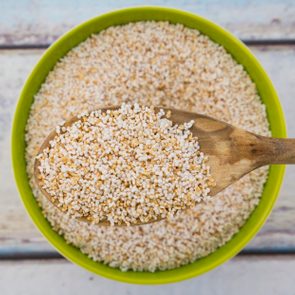5 Benefits of Bulgur, a Whole Grain Nutritionists Love
Updated: May 20, 2021
Bulgur is a packed with protein, fiber, and vitamins and minerals. Here are the benefits of bulgur, how to cook it, and recipes for making this whole grain.
What is bulgur?
There’s a good chance that if you’ve heard of bulgur, it’s because you’re familiar with tabbouleh, a Middle Eastern salad made with cooked bulgur, tomatoes, cucumbers, parsley, mint, and a fresh-squeezed lemon dressing.
The star of the salad, is a type of cereal grain made by breaking up whole wheat kernels. Typically, it comes from durum wheat but can be from other wheat varieties.
“Bulgur is a whole grain made from wheat berries that have been ground even finer than cracked wheat,” says Danielle Gaffen, registered dietitian nutritionist and nutrition consultant based in San Diego. “The berries have been partially steamed, dried, and then cracked to produce a more pronounced flavor.”
While bulgur (sometimes called bulgur wheat) is often a whole grain, it can also have some of the outer layers removed, says Julie Miller Jones, emeritus professor of nutrition at St. Catherine University in St. Paul, Minnesota, and a member of the Grain Foods Foundation’s Scientific Advisory Board.
It’s a versatile ingredient that can be combined to make an array of delicious dishes.
“Bulgur has a pleasing, hearty texture and nutty flavor that’s a blank slate for pairing with other nutritious ingredients, like olive oil, vegetables, beans, seafood, nuts, and fresh herbs, to name a few,” says Beth Stark, registered dietitian nutritionist and nutrition consultant, writer, and recipe developer in Harrisburg, Pennsylvania.
The origins of bulgur
Because bulgur comes from wheat, it’s considered a type of grass and is part of the Poaceae family.
Originating in the Mediterranean, the grain has been an important crop and food source throughout this region as well as the Middle East.
These days, though, it’s widespread across the United States and a grain-aisle staple at the grocery store. Americans are snapping it up as a good way to get a greater variety of healthy whole grains.
“It’s also well suited for individuals seeking to eat more plant-based meals and/or those following a vegetarian or vegan diet,” says Stark.
Bulgur nutrition facts
This whole grain is full of nutrition. “It’s a source of essential vitamins and minerals, like iron, potassium, magnesium, and phosphorus,” says Stark.
Here are the nutritional benefits and recommended daily values (DV) of one cup of cooked bulgur (182 grams):
Calories: 151
Carbohydrates: 34 g (12 percent DV)
Protein: 5.6 g (11 percent DV)
Fat: 0.4 g (1 percent DV)
Fiber: 8.2 g (29 percent DV)
Sodium: 9.1 mg (0 percent DV)
Sugar: 0.2 g
Calcium: 18.2 mg (1 percent DV)
Folate: 32.8 mcg (8 percent DV)
Iron: 1.75 mg (10 percent DV)
Magnesium: 58.2 mg (15 percent DV)
Manganese: 1.1 mg (48 percent DV)
Potassium: 124 mg (3 percent DV)

Health benefits of bulgur
There’s a lot to love about bulgur, and we’re not just talking about its slightly nutty flavor and chewy texture.
“As a whole grain, bulgur is naturally a nutritious addition to your everyday meals,” says Stark. “In general, a diet rich in whole grains is linked to lower risk for heart disease, type 2 diabetes, obesity, and certain cancers.”
One of the main draws of this healthy grain is its high fiber content, which is important for a healthy body.
“Fiber has been linked with improving digestion and gut health, helping us stay full, and promoting weight loss, improving blood sugar responses and even insulin sensitivity, and overall reducing chronic disease risk,” says Gaffen.
Improves digestion
Fiber aids digestion by keeping our digestive tract running smoothly.
“Eating enough fiber promotes regular bowel movements and can help prevent constipation,” explains Stark.
Its benefits don’t stop at helping you stay regular. The fiber in bulgur can promote good gut health too.
“Whole grains like bulgur can promote the good-for-you gut bacteria in the microbiome that can help with digestion and intestinal health,” says Gaffen.
Boosts heart health
Fiber does more for your body than aid the digestive tract. It also helps reduce cholesterol and can have a positive effect on the heart.
“Whole grains and dietary fiber can help lower total and LDL [low-density lipoprotein] cholesterol, which reduces the risk of heart disease,” says Gaffen. “Additionally, bulgur is low in sodium, and consuming low-sodium foods can help prevent high blood pressure.”
In fact, fiber is one of the best foods for your heart.
“For optimal heart health, experts recommend eating primarily whole grains and at least 25 grams of fiber per day for women and 38 grams per day for men,” says Stark.
Bulgur is a low-glycemic food
Each food takes a certain amount of time to be digested or processed in our bodies. How long that takes depends on the amount of carbohydrate, fat, and protein it has.
Fiber, which bulgur has a lot of, tends to slow the digestion process. When food takes longer to digest, it lessens the spike, or sudden increase, in blood sugar.
Foods that don’t raise blood sugar as quickly are classified as having a low glycemic index.
“Bulgur may help people with diabetes control and improve blood sugar responses, and even insulin sensitivity, due to its fiber,” says Gaffen.
Lower risk for colon cancer
By now, it should be clear that food we eat directly impacts our bodies. In the case of bulgur, its fiber content has a ripple effect.
Not only can it protect your gut, but a healthy gut lowers your risk for other diseases.
“Having a healthy gastrointestinal (GI) tract may also contribute to a lower risk for colon cancer,” explains Stark.
Helps weight loss
Eating a diet rich in fiber can help reduce appetite by keeping you full and satisfied for longer. And that means you’re likely to eat less.
“Fiber is very satisfying and can help maintain appetite control, possibly aiding in weight management,” says Stark. “Achieving and maintaining a healthy weight may lower overall risk for heart disease, high blood pressure, and cholesterol.”
Over the long term, eating sufficient fiber can help you maintain your weight or even lose weight.
A couple caveats
Is bulgur gluten free?
The answer is no.
Because bulgur comes from different types of wheat, it naturally has gluten proteins.
“Bulgur is a form of wheat, so it is not gluten-free, meaning that it is not appropriate for people with wheat allergies, celiac disease, or gluten intolerances,” says Gaffen.
Did we mention bulgur wheat is high in fiber?
As we said, that’s a good thing. Fiber is important to include in your eating plan.
However, make sure to add it to your diet slowly if your diet has previously been relatively low in fiber.
Although it’s known for helping with bowel movements, getting too much fiber too fast can cause the opposite effect.
“If increasing the amount of fiber in the diet, do so slowly to reduce the chances of gas, bloating, and/or constipation, says Gaffen. “And drink plenty of fluids—more fiber without more fluids will just lead to constipation!”
How to eat bulgur
You can eat this versatile whole grain at any meal. So if you want more variety to your morning routine, consider eating bulgur as a porridge. For lunch or dinner, use it as a base for a salad or side dish.
Want an alternative to rice? Bulgur’s a good pick.
“It can be cooked and enjoyed as a pilaf, the base of a grain bowl, or on a salad,” says Stark. “Try it in soups and casseroles too.”
Gaffen suggests adding bulgur to stews, using it in veggie burgers, or replacing similar grains (like rice or couscous) with bulgur.
The grain is “traditionally used in the Middle Eastern ground lamb dish called kibbeh,” says Jones.
And, of course, there’s tabbouleh, which makes for a refreshing summertime side dish.
How to cook bulgur
One of the best things about bulgur wheat is how simple and quick it is to make. You prepare it a lot like rice, adding a mix of grain and water.
Aim for a ratio of approximately 1.5 cups of water or broth to 1 cup bulgur.
It typically takes about the same amount of time to cook as rice, but some varieties cook in less than five minutes.
“Cooking times of bulgur vary depending on the coarseness of the variety purchased,” explains Gaffen. “For example, coarse bulgur will take about 20 minutes to cook, whereas fine bulgur may only take 3 minutes.”
Impatient to try this whole grain? Consider purchasing a fine-grain bulgur so you can whip it up fast.
(Here are healthy meal ideas you can make in 20 minutes.)
Bulgur recipe
Ready to dig in to a bowl of bulgur? Try this recipe for tabouli (another name for tabbouleh), courtesy of Celine Beitchman, health director of nutrition at the Institute of Culinary Education. It appears in the institute’s Health-Supportive Culinary Arts curriculum.
Tabouli
Yield: Approximately 2½ cups
Ingredients:
1 cup bulgur, cooked, still warm
½ cup lemon juice
¼ cup extra-virgin olive oil
½ to ¾ teaspoon salt
2 plum tomatoes, seeded and diced
1 bunch parsley, chopped
4 scallions, thinly sliced
2 ribs celery, diced
½ bunch mint, chopped
Salt and pepper to taste
Instructions:
- In a large bowl, toss warm bulgur with lemon juice, olive oil, and salt. Let sit until it reaches room temperature.
- Combine bulgur with tomatoes, parsley, scallions, celery, and mint, mixing thoroughly.
- Season with salt and pepper to taste.
Get creative in the kitchen with other bulgur wheat recipes:






















